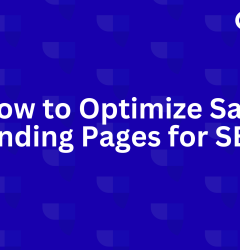02 May

Published by: Amit Kakkar
Published on: May 2, 2025
Last updated on: November 8, 2025
Last Updated on November 8, 2025 by admin
Did you know that 52% of marketers have reported a significant loss in their organic traffic? On the contrary, 60% of Google searches ended without any clicks on websites in 2024.
What’s driving these trends?
Generative Engine Optimization, or GEO as you may have heard, is making traditional SEO less significant day by day. Usually, people put a question in the Google browser and clicked on any of the top 10 websites to get answers. However, with the launch of Perplexity, Google AI Overview, and search features in ChatGPT and other AI chatbots, users no longer find it relevant to explore the top SERP results. They can just ask the AI search tools to get instant answers with credible sources. This has eaten up the traffic websites were getting from SEO.
Generative AI search tools have changed the way users find answers and search for products. And if you are still optimizing only for Google search results, there is a high chance that you might still miss out on getting high traffic and conversions. However, this doesn’t mean that you completely ignore SEO. Most of the AI search tools extract their data from Google or Bing, so you still need to optimize your website for SEO. But the key to reaching your target audience is to merge SEO with GEO in your strategy to create content that’s relevant and valuable for users.
So, if you are also solely dependent on SEO and at risk of missing out on GEO, this blog is for you.
Understanding SEO and GEO
You all already know what SEO is. Still, let’s briefly understand both the terms, SEO and GEO, so the core concept is clear before we move on to the differences and GEO techniques for website optimization.
What is SEO?
SEO is the process of optimizing your website for a higher ranking and better visibility in Google search results. SEO executives and marketers often use keywords relevant to their product or service in their website content, landing pages, blogs, and other content pieces to make it rank on Google. The idea is that when the customer searches for the same keywords, their respective website, webpage, or blog should appear at the top SERP results. This, in turn, gets them clicks and a chance to convert website visitors into loyal customers.
Core components :
- Researching keywords based on volume, keyword difficulty, and intent for better visibility.
- Earning backlinks from credible third-party websites to build website authority.
- Optimizing content following best on-page SEO practices for meta title, description, alt text, content quality, blog structure, and more.
- Creating a content strategy for blogs, landing pages, eBooks, case studies, etc., for the sales funnels using TOFU, MOFU, and BOFU techniques.
What is GEO?
GEO or generative engine optimization refers to the process of optimizing your website and its content for better visibility on AI search tools. ChatGPT, Perplexity, or Google’s AI Overviews don’t search the web like humans do. So SEO is quite different from GEO. Instead of focusing on keywords and backlinks, AI chatbots prefer content based on intent, relevance, and usefulness.
In short, if your content is :
- Helpful to users
- Answers their questions
- Offers real solutions to their problems
Then the AI tools will prefer your content over the fluff.
AI doesn’t see if you have used the concerned keyword in your content, headings, introduction, or meta description. It only analyzes whether your content is valuable concerning the user’s query. If it is, the AI chatbot picks your content, summarizes it, and generates the answer while citing your website as the source. So the user knows where to explore to dig deeper.
For example, a user asked on Perplexity, “How to implement AI agents in my sales processes?”. The AI searches the web and gives him a detailed answer with factors to consider, a step-by-step implementation process, top AI agent companies to contact, and more, with sources. After reading the answers, the user wants to know more about AI agents and which companies offer this service. So, he navigates the sources linked to the answer. Now, if your website is cited in the sources, you might gain a click or a qualified lead.
Core components :
- Create quality content around topics that are relevant and useful to your audience.
- Publish different content formats to build topical authority in the same domain.
- Write blogs and webpages in conversational and simple language.
- Back your facts and data with credible sources to prove you are trustworthy.
- Avoid spammy and fluffy content.
Key Differences Between SEO and GEO
While SEO and GEO share a common goal—boosting visibility—they operate on fundamentally different principles. Understanding these differences is essential for marketers and content creators aiming to stay relevant in both search and generative environments.
Target Platforms
SEO : SEO is designed for traditional search engines such as Google, Bing, and Yahoo. These platforms use web crawlers and algorithms to index, rank, and display web pages in response to user queries.
GEO : GEO targets AI-driven platforms like ChatGPT, Google Bard, and Perplexity. Instead of relying on indexed pages, these platforms generate real-time responses using large language models and often pull information from trusted sources on the web.
Optimization Techniques
SEO : The backbone of SEO includes keyword research, crafting compelling meta descriptions and title tags, and acquiring backlinks. These tactics help search engines understand page relevance and authority.
GEO : GEO takes a different approach. It emphasizes the use of structured data (such as schema markup), high-quality authoritative citations, and content designed for conversational consumption. The goal is to create information that AI systems can easily interpret and integrate into natural language responses.
Metrics for Success
SEO : Success in SEO is often measured by traditional web analytics—click-through rates, bounce rates, organic traffic, and how high a page ranks in search engine results pages (SERPs).
GEO : GEO success is measured through newer indicators such as inclusion in AI-generated responses, citation frequency within those responses, and relevance scores assigned by generative platforms. The focus is less on clicks and more on being referenced by the AI as a trusted source.
How SEO and GEO Complement Each Other?
The rising trend of generative AI search tools and a shift in user behavior compel businesses to optimize their websites for GEO. However, it doesn’t mean that SEO is dead. The secret to getting high traffic on your website is using a combination of SEO and GEO techniques to ensure that your content is ready for both Google and AI search engines.
Why we say this is because when you dig deeper into how LLMs or AI search tools function, you will see that SEO still plays a crucial role. What most of the AI search engines or chatbots do is refer to the top SERP pages, scan their content, and use the facts to generate responses. For example, Perplexity and Gemini use Google index data. ChatGPT refers to Bing search engine data.
However, this doesn’t mean that they replicate exact SERP results. These AI search tools have their own algorithm that instructs the web crawlers to gather and organize information from the internet.
For instance, Perplexity may utilize certain ranking signals or data from various sources to inform its results. But it does not replicate Google’s search outputs. Perplexity’s approach involves combining its proprietary indexing with real-time web data to generate answers, aiming to provide accurate and up-to-date information to users. This strategy allows Perplexity to function independently of traditional search engines like Google, offering a distinct AI-driven search experience.
The key takeaways are :
- You still need to rank on Google or Bing search engines to be visible on AI search tools.
- Your content still needs to be SEO optimized using the right keywords, structure, and other on-page SEO techniques.
- Plus, your content should be GEO optimized by making it more relatable to users, relevant to their interests, and offering solutions to their problems.
- Moreover, you should try including more natural language or long-tail keywords in your content for better visibility on AI search tools.
- Most importantly, place critical facts early in the content for both featured snippets and AI extraction.
- Your website’s speed, performance, and indexability play a crucial role in both SEO and GEO.
- Ask your writers to make your content simpler, clearer, and more conversational.
- Give direct answers to concerned questions in your blogs to bag feature snippets.
- Do not forget to structure your blogs, eBooks and landing pages with proper H1, H2, H3 and H4 headings, making it easier for AI to extract content.
A successful digital strategy in the era of AI combines the techniques of SEO and GEO to bring tangible results. By leveraging both, you make your business future-ready and establish its presence across all digital platforms, from the Google search engine to AI search tools.
Implementing GEO Strategies
Here are some tips to quickly rank your SaaS website on Google, Perplexity, Gemini, and others.
1. Crafting AI-Friendly Content
Writing in a conversational tone
AI search engines prioritize content that mirrors natural human language. Using a conversational tone not only improves readability but also aligns your content with the way users phrase queries in voice and chat-based searches.
Incorporating structured data and clear context
Structured data, like schema markup, helps AI understand the relationships between entities on your page. Combined with clear, contextual writing, it allows search engines to accurately categorize and display your content in rich results.
2. Building Authority and Credibility
Citing reputable sources
Referencing trusted sources—like academic journals, government sites, and industry-leading publications—signals to AI algorithms that your content is reliable and well-researched.
Including expert quotes and data-backed information
Integrating insights from recognized experts and statistics from credible studies enhances content trustworthiness. AI systems can identify and value this depth of information, giving your content an edge in competitive rankings.
3. Monitoring and Adapting
Tools for tracking AI-driven search visibility
Platforms like Google Search Console, Semrush, and AI SEO tools provide insights into how your content performs in AI-influenced search. Tracking these metrics lets you refine and optimize continuously.
Staying updated with AI search engine algorithm changes
AI search algorithms evolve rapidly. Regularly following updates from sources like Google’s Search Central Blog, SEO forums, and AI research publications ensures your strategy adapts with the landscape.
Conclusion
The number one rule of marketing is “Be where your customers are.” With the emergence of AI search tools, users have shifted from traditional search engines to intelligent chatbots that give them instant answers. And if your brand is not visible on AI search tools, you are at risk of losing presence to your competitors who have already adopted GEO.
The smartness is not choosing between SEO and GEO. This is not a competition of which is better for your business. The secret is to merge SEO and GEO for your brand marketing and target your audience wherever they go.
If you are feeling overwhelmed by all this information, remember you don’t have to do it alone. Growthner, a leading SaaS marketing agency, has helped reputed brands gain more visibility on AI search tools like ChatGPT, Perplexity, Gemini, and others. We can help you, too. Get in touch with our GEO experts today!







Amit Kakkar